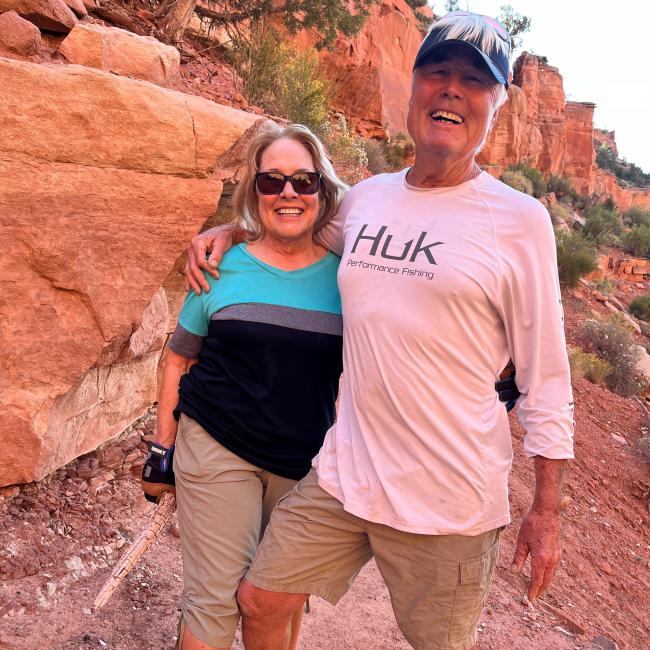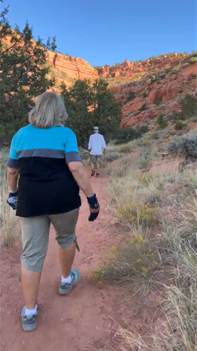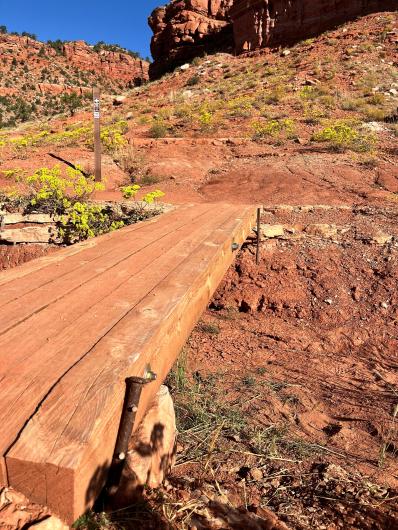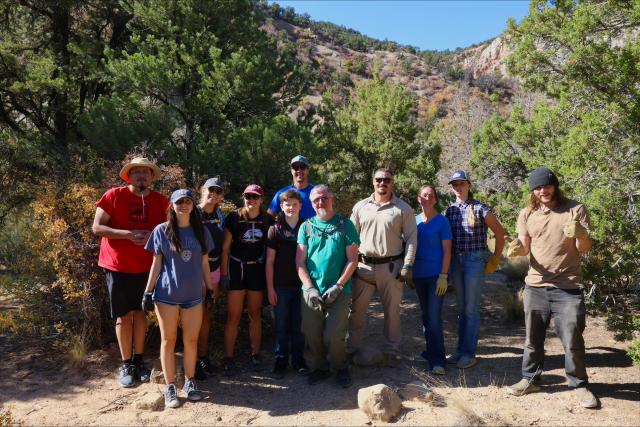Utah couple exemplifies the enthusiasm and dedication of BLM's many volunteers
Listen
Subscribe
Related Content
In this holiday season of giving, the BLM sincerely thanks the many thousands of volunteers who have freely given their time and efforts to care for public lands. Highlighted in this podcast episode are Sue and Jim Johnston, a couple out of Utah who have been making a difference in our trails in Kanab for more than 10 years. Their positive impact and attitudes towards maintaining public lands, as well as laying the groundwork for future preservation long after they’re gone, is what sets them apart as an admirable model for future generations to follow. The duo has received BLM’s Outstanding Volunteer Achievement Award for their continued dedication to beauty and workable recreation.
Transcript
NARRATOR [Mitchell C. Leverette, Public Affairs Specialist]: The BLM will always appreciate the many volunteers who support the care of the nation’s natural and cultural resources across various programs. It’s no easy task to contribute to these BLM program areas while also helping to strengthen the friendly ties in the regions these volunteers serve. The lasting positive impact BLM volunteers continuously have on public lands and communities is invaluable.
My name is Mitchell Leverette, and you’re listening to “On The Ground, A Bureau of Land Management Podcast.” Hailing out of the dry, arid, and rocky landscape of Kanab, Utah are longtime volunteers Sue and Jim Johnston. The couple has committed hundreds of hours towards maintaining Kanab’s Raven, Roadrunner, Bunting, Cottonwood, and Tilted Mesa Trails, while also showing no signs of stopping anytime soon. I had the opportunity to speak with Cindy Gallo, a public affairs specialist based in Salt Lake City, who recently spent time with the Johnstons and had the true privilege of learning more about them and their projects.
CINDY GALLO, Public Affairs Specialist, BLM Utah: Yeah, so Sue and Jim Johnston have been longtime volunteers with the BLM in Kanab. It's been over at least ten years that they've been working with us. I heard about them, and this was an assignment for me, I was heading down to Kanab from the state office. “Hey, while you're down there, can you swing by and have a chat with them? Let's get their story.” This year, we awarded them the outstanding Volunteer Achievement award for all of their work. And so, I called up Sue and said “Hey, we'd love to chat with you. Are you free?” And she was enthusiastic. We met at a trailhead just north of Kanab that heads out to BLM land and its multiple trails actually, that they have maintained and partially created over the years. They're just incredible individuals and it was just special. We were out there for about an hour kind of doing a walk and talk and telling me about some of the projects and why they do it and it was awesome.
LEVERETTE: What were their first impressions like? Did they display any sort of dynamic between each other. Did they talk about kind of what their roles are with all these projects? Can you elaborate on this?
GALLO: Yeah, so Sue and Jim, like automatically you meet them and they just have such a rapport with each other. We kind of named them and they kind of named themselves the “Brains and Braun” of their little duo, right. They have been married a long time and it's, you know, very, you know very “couple back-and-forth.” Jim exalts over Sue’s ability to manage things, she's really the brains of the operation. She's the one, you know, reaching out to people and getting them invested and organized. And Jim is the guy that just really likes to get his hands dirty. He loves the, you know, hands on work. He loves picking up a shovel or a pickaxe and doing the hard work of building signs and building trails and maintaining them, he likes to see that final product and of a trail completed. So, it was really easy to see that go between them and he'd say, “Oh yeah, this it,” and she'd say “Oh, we coordinated the building in this bridge,” and he’d say Oh, yeah, no, we got it from found materials.” So, they really just lay off of each other in such a great way that is collaborative and it makes, I think, a bigger impact because they can bounce off of each other 's strengths.
LEVERETTE: Now, from being with them for so long, did they ever talk about what their takeaways are from doing volunteering for so long? Did they ever go in depth about how any of their projects have impacted their day-to-day lives? Did they take any lessons or values from taking part in all these projects?
GALLO: Yeah, um, I think for them volunteerism is really core to who they are. They have been doing this not only in Kanab for ten years, but they both said, you know, we've been involved in community service back when we lived in Jackson Hole, Wyoming. That this is just who we are. If we're recreating on the land, it's important to us that we're giving back. It's important to us that we're taking responsibility. By making sure the places we love are well cared for. They love seeing other people catch that service bug, right? That's really core, and when I asked them, you know, “Why do you do this?” Like, “What do you get from this? What's the takeaway?” For Sue, it was really about beauty. She loves the beauty of our wild public lands. She wants that beauty to stay. For Jim, it's really about making an impact and making a difference and making sure that there are places to recreate that, you know, he wants to be the change agent. He wants to make sure that there are opportunities, that we're not just leaving that to the whims of, you know, someone else. He's the one out there doing work.
LEVERETTE: Now, what were your main takeaways from talking to them about volunteering for so long? Did your perspective on what it means to actually be a “volunteer” change from talking with them?
GALLO: You know, I think talking with them really renewed a sense of “volunteerism is a lifelong love.” You know, and especially with BLM, I think I didn't understand how much our volunteers do, how important they are to really getting things done. You know, I think we think with the federal government of all you know, oh, there's just, there's this bias of or maybe perspective if there's so much red tape to get anything done, and I think these volunteers really showed me what can be done to make our public lands better. By just taking that ownership of “You know what we got this! We're going to go take care of it. We're going to go maintain these trails because we love it. We want future generations to enjoy it. We want it to be here for future generations.” So, I think it’s really, it goes back to “you can talk to talk, but could you walk the walk” and these two [Sue and Jim] really walk the walk.
LEVERETTE: So, you had kind of touched on this before when you were kind of explaining their visions for the projects, the areas that they've been working on for so long. Do they themselves have any sort of plans on calling it a day on their operations? Do they have any future endeavors of their own?
GALLO: So, I think they’re still very much wanting to be active and involved in this. However, I think they recognize they're not getting any younger and that's really what's driving Sue's newest adventure: this Adopt-A-Trail program in Kanab. I think they recognize that [the program] is going to need future legs. We need to be able to hand this off to other people to continue to maintain, and so she's trying to, you know, get a grass, this grassroots program up where businesses or nonprofits or just people in general can adopt some of these trails down in Kanab, where they can make sure that they're going to do regular maintenance, you know, days or volunteer days or clean up days, whatever needs to be done so that all of this work that they’ve created, these networks that they've put in place, because it's not just them, right? They're kind of the change agents, but they’ve really mobilized a lot of people in Kanab to recognize the importance of this volunteer work, and I think that they're just trying to put into place the next phase, which is making sure future generations and future residents are continuing to maintain these amazing recreation opportunities.
LEVERETTE: Special thanks to Cindy Gallo for taking the time to meet and provide fantastic insight on the volunteer operations of Sue and Jim Johnston, a couple who truly personify BLM’s Mission of sustaining the health, diversity, and productivity of public lands for the present and future. Links to additional coverage of the Johnstons from both from Cindy Gallo and BLM Utah will be posted on our website. Thanks for tuning in. Once again, this is Mitchell Leverette, and we’ll see you out there, “On The Ground.”





